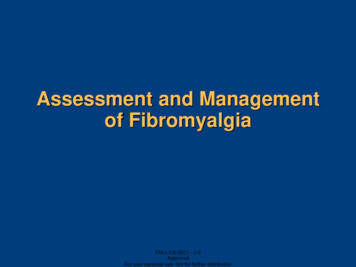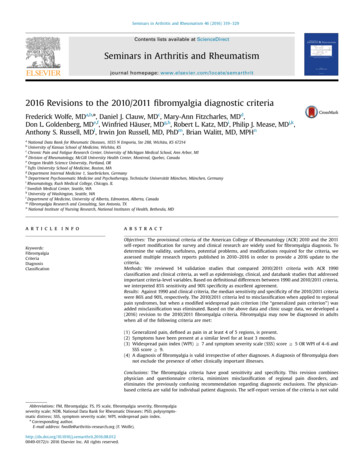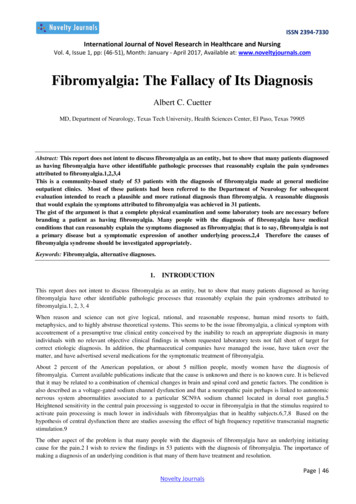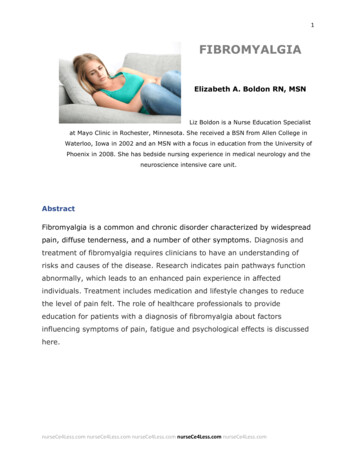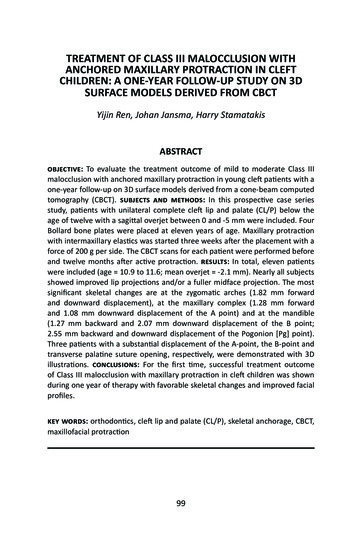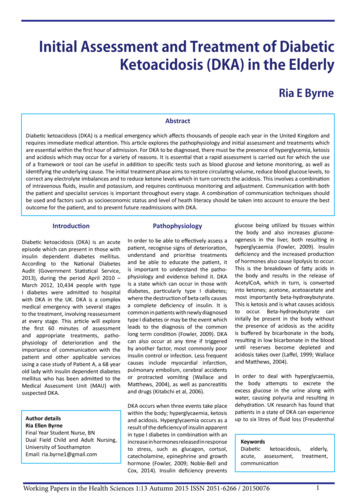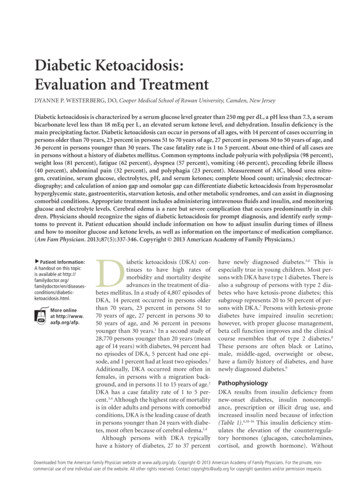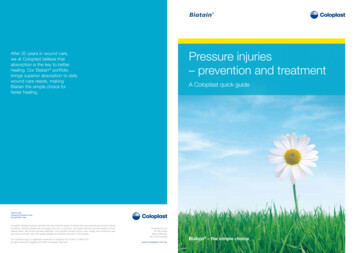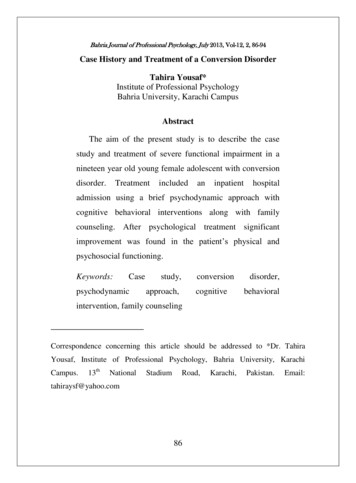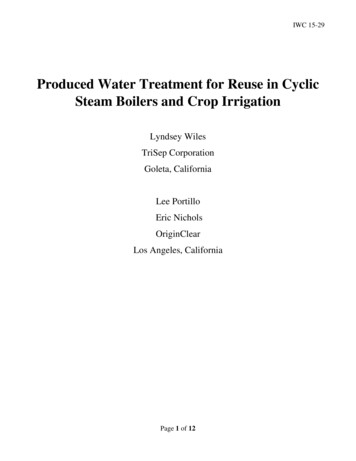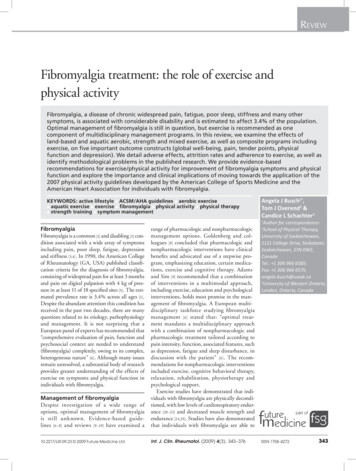
Transcription
ReviewFibromyalgia treatment: the role of exercise andphysical activityFibromyalgia, a disease of chronic widespread pain, fatigue, poor sleep, stiffness and many othersymptoms, is associated with considerable disability and is estimated to affect 3.4% of the population.Optimal management of fibromyalgia is still in question, but exercise is recommended as onecomponent of multidisciplinary management programs. In this review, we examine the effects ofland-based and aquatic aerobic, strength and mixed exercise, as well as composite programs includingexercise, on five important outcome constructs (global well-being, pain, tender points, physicalfunction and depression). We detail adverse effects, attrition rates and adherence to exercise, as well asidentify methodological problems in the published research. We provide evidence-basedrecommendations for exercise/physical activity for improvement of fibromyalgia symptoms and physicalfunction and explore the importance and clinical implications of moving towards the application of the2007 physical activity guidelines developed by the American College of Sports Medicine and theAmerican Heart Association for individuals with fibromyalgia.KEYWORDS: active lifestyle n ACSM/AHA guidelines n aerobic exercisen aquatic exercise n exercise n fibromyalgia n physical activity n physical therapyn strength training n symptom managementAngela J Busch1†,Tom J Overend2 &Candice L Schachter1Author for correspondence:School of Physical Therapy,University of Saskatchewan,1121 College Drive, Saskatoon,Saskatchewan, S7N 0W3,CanadaTel.: 1 306 966 6585;Fax: 1 306 966 6575;angela.busch@usask.ca2University of Western Ontario,London, Ontario, Canada†FibromyalgiaFibromyalgia is a common [1] and disabling [2] condition associated with a wide array of symptomsincluding pain, poor sleep, fatigue, depressionand stiffness [3,4] . In 1990, the American Collegeof Rheumatology (GA, USA) published classification criteria for the diagnosis of fibromyalgia,consisting of widespread pain for at least 3 monthsand pain on digital palpation with 4 kg of pressure in at least 11 of 18 specified sites [5] . The estimated prevalence rate is 3.4% across all ages [1] .Despite the abundant attention this condition hasreceived in the past two decades, there are manyquestions related to its etiology, patho physiologyand management. It is not surprising that aEuropean panel of experts has recommended that“comprehensive evaluation of pain, function andpsychosocial context are needed to understand(fibromyalgia) completely, owing to its complex,hetero geneous nature” [6] . Although many issuesremain un resolved, a substantial body of researchprovides greater understanding of the effects ofexercise on symptoms and physical function inindividuals with fibromyalgia.Management of fibromyalgiaDespite investigation of a wide range ofoptions, optimal management of fibro myalgiais still unknown. Evidence-based guidelines [6–8] and reviews [9–19] have examined arange of pharmacologic and nonpharmacologicmanagement options. Goldenberg and colleagues [8] concluded that pharmacologic andnon pharmacologic interventions have clinicalbene fits and advocated use of a stepwise program, emphasizing education, certain medications, exercise and cognitive therapy. Adamsand Sim [9] recommended that a combinationof inter ventions in a multi modal approach,including exercise, education and psycho logicalinter ventions, holds most promise in the management of fibromyalgia. A European multidisciplinary taskforce studying fibro myalgiamanagement [6] stated that: “optimal treatment mandates a multidisciplinary approachwith a combination of nonpharmacologic andpharmaco logic treatment tailored according topain intensity, function, associated features, suchas depression, fatigue and sleep disturbance, indiscussion with the patient” [6] . The recommendations for non pharmacologic interventionsincluded exercise, cognitive behavioral therapy,relaxation, rehabilitation, physiotherapy andpsychological support.Exercise studies have demonstrated that individuals with fibromyalgia are physically decondi tioned, with low levels of cardio respiratory endurance [20–23] and decreased muscle strength andendurance [24,25] . Studies have also demonstratedthat individuals with fibromyalgia are able to10.2217/IJR.09.23 2009 Future Medicine LtdInt. J. Clin. Rheumatol. (2009) 4(3), 343–3761ISSN 1758-4272343
ReviewBusch, Overend & Schachterperform aerobic, flexibility and muscle strengthtraining programs. While exercise has been identified as a component of fibromyalgia management,not all clinically relevant and practically importantaspects of this modality have been clarified.Physical activity & exercise definedThis review examines the evidence for pre scriptionof exercise and recreational physical activity forindividuals with fibromyalgia. Exercise training(referred to in this review as exercise) is “planned,structured, and repetitive bodily movements performed to improve or maintain one or more components of physical fitness” [26] . Exercise employsthe principles of overload and progression, andspecifies intensity, frequency and duration of exercise in order to achieve its goal of improving physical fitness. Exercise can be further subdividedinto aerobic, strength and flexibility training, allof which can result in specific improvements inthe respective target areas. By contrast to exercise,recreational physical activity includes any physicalactivity for recreational purposes and sport, without necessarily presuming a specific emphasis onfitness or competition. While recreational physical activity (referred to as physical activity in thisreview) implies a less prescriptive endeavor thanexercise, there is overlap between the two, owingto both the ways that each is recommended byclinicians and the ways that each is undertakenand performed. For example, a walking programthat is undertaken for enjoyment as a recreationalactivity may be shaped into an exercise programas an individual begins to (or is advised to) walkmore briskly for longer periods of time or morefrequently. To date, the research focus has been onexercise for individuals with fibromyalgia. We willexplore the application of both structured exerciseprograms and less prescriptive physical activityprograms for individuals with fibromyalgia.PurposeThe purposes of this paper are:nnnn344To review the effects of exercise and physicalactivity in adults with fibromyalgia;To discuss clinical implications of incorporating exercise and/or physical activity intheir lives;To evaluate the findings of studies on exercisefor fibromyalgia in the context of currentphysical activity guidelines;To suggest future directions for exercise andphysical activity as management tools inthis population.Int. J. Clin. Rheumatol. (2009) 4(3)MethodWe searched for randomized clinical trials (RCTs)without language restriction using Medline(1966 to September 2008), the CumulativeIndex to Nursing and Allied Health Literature(CINAHL ) (1982 to September 2008), theExcerpta Medica Database (EMBASE) (1974 toSeptember 2008), and the Cochrane ControlledTrials Register (2008, issue 3). We used keywordsand medical subject headings (MESH) headingsto denote fibromyalgia and a wide spectrum ofphysical activity and exercise. Sources were alsoidentified by examining reference lists from relevant research reports. After screening citationsand abstracts, full text articles were examined.Studies of adults with fibromyalgia using: published criteria for diagnosis of fibromyalgia [5,27–30],randomized designs including either an untreatedcontrol group or a non exercise intervention, and atleast one intervention in which exercise/physicalactivity was a significant component were includedin this review. Types of interventionsIn this review, we focused exclusively on threetypes of exercise: aerobic, strength and flexibility,excluding from consideration other types, such asbalance. We classified exercise interventions firstinto land-based and aquatic categories. Withinland-based and aquatic categories, exercise wasclassified by type(s) (excluding warm-up andcool-down): aerobic, strength, or flexibility forthose that included only one type of exercise,or mixed (which included some combination ofaerobic, strength and flexibility training). Theseinterventions were also described as ‘exercise-only’interventions, in contrast with composite interventions that included both exercise and non exercise components. Within composite interventions, the exercise components were identifiedaccording to the description above. No restrictions on frequency, intensity or duration of exercise were made beyond the requirment that theexercise component of composite interventions bea substantial part of that treatment. Data extraction & managementStudy characteristics and point estimates for outcome measures were extracted from each study.When multiple measurements were taken acrosstime, we based our calculations of effect sizes andmeta-analysis on data collected at approximately12 weeks. This duration was chosen becausethere is ample evidence that physio logical adaptation will occur by 12 weeks; this was a common length for the programs being studied and,future science group
Fibromyalgia treatment: the role of exercise and physical activitytherefore, would allow better comparison acrossstudies. We preferentially extracted intention-totreat data if available. Some authors have beencontacted to obtain more data, but this has notbeen executed systematically. Methodological quality assessmentUsing the 11 item internal validity subscale ofthe van Tulder methodological quality assessment instrument [31] , we classified studies intolow and moderate-to-high methodologicalquality categories using arbitrary groupingsof four or less for low-quality studies, and fiveto 11 for moderate-to-high quality studies. Forfull details of our application of this scale seeBusch et al. [32] . Evaluation of congruence ofexercise/physical activity withrecognized guidelinesWe evaluated congruence of exercise interventions with the American College of SportMedicine (ACSM; IN, USA)/American HeartAssociation (AHA; TX, USA) (ACSM/AHA)guidelines for physical activity and public healthfor adults [33] and for older adults [34] . As partof this evaluation, we classified the intensity ofexercise interventions using the classification ofphysical activity intensity advocated by ACSMin 2009 [35] . The guidelines for adults [33] recom mend that healthy adults aged 18–65 years needmoderate-intensity aerobic physical activityfor a minimum of 30 min for a minimum of5 days per week, or vigorous intensity aerobicphysical activity for a minimum of 20 minon 3 days per week (or a combination of thetwo). Moderate intensity is described as activity requiring between three and six metabolicequivalents and vigorous as activity above sixmetabolic equivalents. The physical activity canbe carried out either continuously or in blocksof 10 min or more, using any mode of aerobicexercise involving use of major muscle groups inrhythmic activities. For muscle strengthening,the ACSM 2009 guidelines [35] advise resistancetraining for 2–3 days per week with at least 48 hseparating the exercise training sessions for thesame muscle group. To improve muscular fitness, “adults should train each muscle groupfor a total of 2–4 sets with 8–12 repetitionsat 60–80% of the one repetition maximumper set with a rest interval of 2–3 min betweensets. For older and very deconditioned persons,one or more sets of 10–15 repetitions of mode rate intensity (i.e., 60–70% one repetitionmaximum) resistance is recommended” [35] .future science groupReviewThe ACSM/AHA recommendations for olderadults [34] address individuals who are 65 yearsand older and adults aged 50–64 years withclinically significant chronic conditions and/orfunctional limitations that affect movementability, fitness or physical activity. These guidelines differ between adults in their definition ofaerobic intensity and recommended intensity ofstrength training. Moderate intensity aerobicactivity is described as a rating of five or six on aten-point scale and vigorous activity as a sevenor eight. The recommendation for strengthening exercises is also 8–10 exercises involving themajor muscle groups, but advises using a set of10–15 repetitions using resistance that representsmoderate to high effort (5–6 and 7–8 on a scalein which zero is ‘no effort’ and ten is ‘maximaleffort’). These guidelines also advocate flexibility activity for at least 2 days per week for atleast 10 min and the use of balance exercises. Weevaluated flexibility training according to theACSM 1998 position stand that describes dosagerequirements as: frequency of exercise equal toor greater than two days per week, intensity toa position of mild discomfort, and three–fourrepetitions of each stretch held for a durationof 10–30 s [36] . Outcome measuresWe grouped the outcome measures into five constructs: global well-being or perceived improvement in fibromyalgia symptoms as assessed by thestudy participant or observer, pain intensity, tender points, observed physical function (reflectedby tests evaluating the cardio respiratory system,muscle strength or flexibility), and depression.When researchers reported more than one measure for any one construct, we used the followingorder of preference for analysis:nnnnnGlobal well-being: fibromyalgia impactquestion naire (FIQ) total, subject-rated visualanalog scale (VAS) or ordinal scale, healthprofessional-rated change, quality of life scale,sickness impact profile total;Pain: VAS, FIQ pain subscale, ordinal scale;Tender points: dolorimetry, total myalgicscore, tender point count;Physical function: selected on a case-by-casebasis depending on researchers’ stated objectives;Depression: Beck cognitive, Beck total, Centerfor Epidemiologic Studies-Depression scale,FIQ-depression, arthritis impact measureme
Index to Nursing and Allied Health Literature . lished criteria for diagnosis of fibromyalgia [5,27–30], randomized designs including either an untreated control group or a nonexercise intervention, and at least one intervention in which exercise/physical activity was a significant component were included in this review. nypes of interventionsT In this review, we focused exclusively on .
